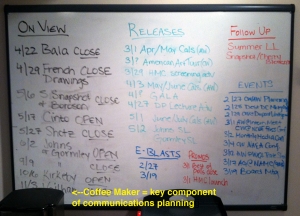May was a busy month for both mentor and mentee. Suzanne opened Maharaja: The Splendors of India’s Great Kings (on view through August 19), and I prepared to open Jasper Johns: Variations on a Theme and Antony Gormley: Drawing Space (both through September 9), as well as a new museum cafe, Tryst at the Phillips. To manage the sheer volume, we gave our May mentorship exchange a miss and took a little break from blogging. But silence can be deceptive. Throughout the month, mentorship was especially on my mind as I noticed changes in my work, evidence of Suzanne’s guidance and ideas sparked by our conversations. Some highlights:
- I packed my latest press release with hyperlinks, program highlights, and relevant citywide events
- Accessibility and welcome is the core of a summer ad campaign I’ve been involved in, which positions the Phillips as the “place to be” and features extended hours every Thursday night (social networks are fully integrated)
- We paid it forward with a guest post about mentorship on the Emerging Museum Professionals blog
- I now augment press releases with timely blog posts (coordinated through a new layer on Google calendar)
- Plus, spring yielded a flourishing first vegetable garden for the Wichmann family. I’d be remiss not to note Suzanne’s encouragement on the work-life-balance front.



